
Grevillea preissii is a species of flowering plant in the family Proteaceae and is endemic to the southwest of Western Australia. It is a mounded to spreading or dense, erect shrub, the leaves divided with 5 to 7 linear to more or less cylindrical lobes, and groups of reddish flowers arranged along one side of the flowering rachis.
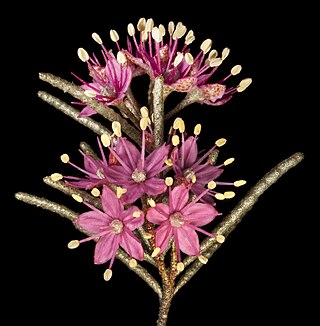
Phebalium is a genus of thirty species of shrubs or small trees in the family Rutaceae and is endemic to Australia. The leaves are arranged alternately, simple and often warty, the flowers arranged singly or in umbels on the ends of branchlets or in leaf axils, usually with five sepals, five petals and ten stamens. There are about thirty species and they are found in all Australian states but not in the Northern Territory.

Phebalium squamulosum , commonly known as scaly phebalium or forest phebalium, is a species of shrub or slender tree that is endemic to eastern Australia. It has smooth branches covered with rust-coloured scales, linear to elliptical or egg-shaped leaves with the narrower end towards the base, and pale to bright yellow flowers in umbels with rust-coloured or silvery scales on the back.

Philotheca salsolifolia is a species of flowering plant in the family Rutaceae and is endemic to New South Wales and the Australian Capital Territory. It is a shrub with crowded, more or less cylindrical leaves and pink to mauve flowers with a dark central stripe and arranged singly or in twos or threes on the ends of branchlets.

Phebalium glandulosum, commonly known as desert phebalium, is a species of shrub that is endemic to eastern Australia. It has glandular-warty stems covered with silvery to rust-coloured scales, wedge-shaped leaves that are scaly on the lower surface, and yellow flowers arranged in umbels on the ends of branchlets.

Philotheca buxifolia is a species of flowering plant in the family Rutaceae and is endemic to New South Wales. It is a shrub with more or less oblong leaves and solitary white to pink flowers arranged singly on the ends of branchlets.
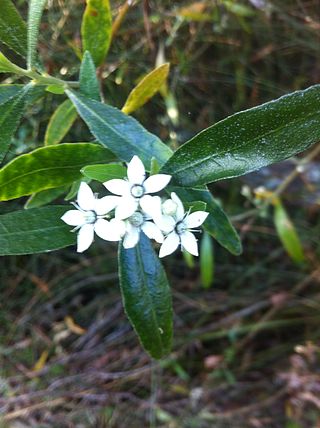
Rhadinothamnus anceps, commonly known as blister bush, is a shrub belonging to the genus of Rhadinothamnus, which is endemic to Western Australia.

Boronia juncea is a plant in the citrus family, Rutaceae and is endemic to the far south-west of Western Australia. It is an erect shrub with linear, short-lived leaves and groups of up to eight white to pink, four-petalled flowers.
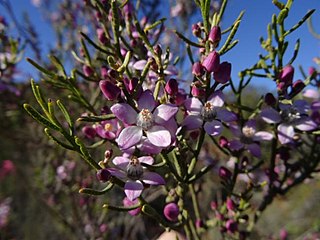
Philotheca brucei is a species of flowering plant in the family Rutaceae and is endemic to Western Australia. It is a shrub with cylindrical leaves grooved along the top and in spring, white to pink or mauve flowers with five egg-shaped petals.
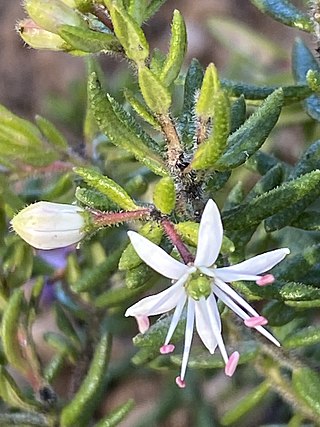
Leionema gracile, commonly known as Mt Greville phebalium, is a shrub species that is endemic to Queensland, Australia. It is a small shrub with spreading leaves, white petals and flowers from autumn to spring.
Leionema hillebrandii, commonly known as Mount Lofty phebalium, is a perennial, woody shrub endemic to South Australia. It has variable shaped leaves and pinkish flowers from late winter to spring.
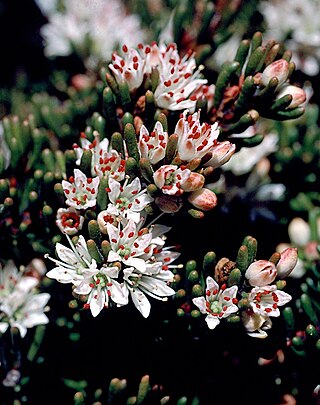
Leionema montanum, is a small shrub with terminal clusters of white-pink flowers in upper leaf axils in spring. It is endemic to Tasmania.
Phebalium brevifolium is a species of small shrub that is endemic to Western Australia. It has warty branchlets, sessile, wedge-shaped leaves and up to three white flowers arranged in umbels.

Leionema ralstonii, is a small shrub with angular, smooth branchlets and pale green flowers in winter. It is restricted to the south coast of New South Wales.
Leionema sympetalum, commonly known as Rylstone bell, is a shrub with greenish-yellow tubular flowers in small terminal clusters at the end of smooth, angular branches. It has a restricted distribution, grows near Rylstone in New South Wales.
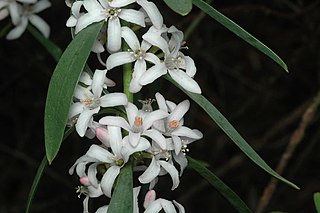
Philotheca conduplicata is a species of flowering plant in the family Rutaceae and is endemic to eastern Australia. It is a shrub with elliptical leaves clustered near the ends of the branchlets and white flowers arranged singly or in two or threes on the ends of the branchlets.

Philotheca epilosa is a species of flowering plant in the family Rutaceae and is endemic to eastern Australia. It is a shrub with egg-shaped to lance-shaped leaves with the narrower end toward the base and crowded near the ends of the glandular-warty branchlets, and white flowers usually arranged singly on the ends of the branchlets.

Philotheca gardneri is a species of flowering plant in the family Rutaceae and is endemic to the south-west of Western Australia. It is a shrub with crowded, narrow club-shaped or more or less spherical leaves and white flowers with a prominent pink midrib, usually borne singly on the ends of branchlets.

Philotheca scabra is a species of flowering plant in the family Rutaceae and is endemic to New South Wales. It is a small shrub with variably shaped leaves, depending on subspecies, and single white to pink flowers arranged on the ends of branchlets.
Patersonia rudis, commonly known as hairy flag, is a species of plant in the iris family Iridaceae and is endemic to the south-west of Western Australia. It is a tufted, rhizome-forming perennial herb with linear to sword-shaped leaves and violet tepals.
















